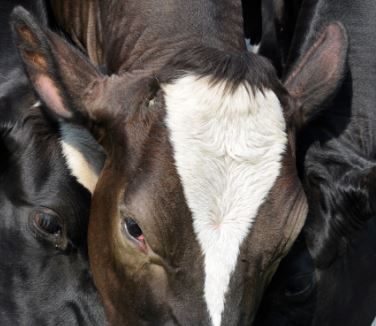



Calf Hair Could Indicate Foul Mood
Facial hair on cows can be an indicator of temperament, potentially informing decisions about showring selection.Technically known as a trichoglyph, the whorl of facial hair can also indicate reaction to novel environments and breeding soundness, writes Alyssa Couse of the William H Miner agricultural research institute.
This insight could be used when selecting heifers for various roles on the farm.

The connection with temperament is because hair follicles and skin develop from the same epithelium, or cell layer, as the nervous system.
The brain is of course where the nervous system is controlled and it is crucial for it to develop properly to allow the animal to function and behave normally, writes Alyssa.
Whorl Research
Several studies have used facial hair whorls as a tool to evaluate temperament. Location on the face, shape, and direction of the whorl are important features to observe. Hair whorls are considered to be high if they are located above the eyes or low if they are below the eye line.
You can note where the whorl is located laterally but it seems that its vertical location is the most useful. The ideal whorl to look for is one with a round epicenter that is centrally located between the eyes. These cattle are the most likely to be calm, reasonable to manage and adapt well to novel environments.
If a whorl is found higher on the face or is abnormally shaped, such as a lightning bolt shape, there is a greater chance the animal will be more excitable, nervous and harder to manage than cattle with whorls between the eyes or below.
The direction in which the swirl turns is typically clockwise, counter clockwise, or radial. Swirl direction has been associated with handedness in other species, like horses, but not cattle. An animal that lacks facial hair whorls entirely tend to be more aggressive and easily agitated than those with whorls. In addition to temperament, research is exploring what other predictions can be made using facial hair whorls.
Fertility and Growth
Research has shown that hair whorl patterns could also be a predictor of fertility and growth rate.
It was found that bulls with a round whorl between his eyes were more likely to have high quality sperm. This is due to testicular development occurring around the same time as hair follicle development of a fetus.
Studies have also suggested that young cattle with higher whorls tend to grow faster. Heifers with high whorls have been shown to be significantly heavier than those with medial and low whorls after 360 days in age.
While hair whorls are only one of many factors that may affect temperament, fertility, and growth, it is safe to say that this easily identifiable trait may provide important information when making culling decisions. Evaluating hair whorls can be done at any stage of life because hair patterns never change.


